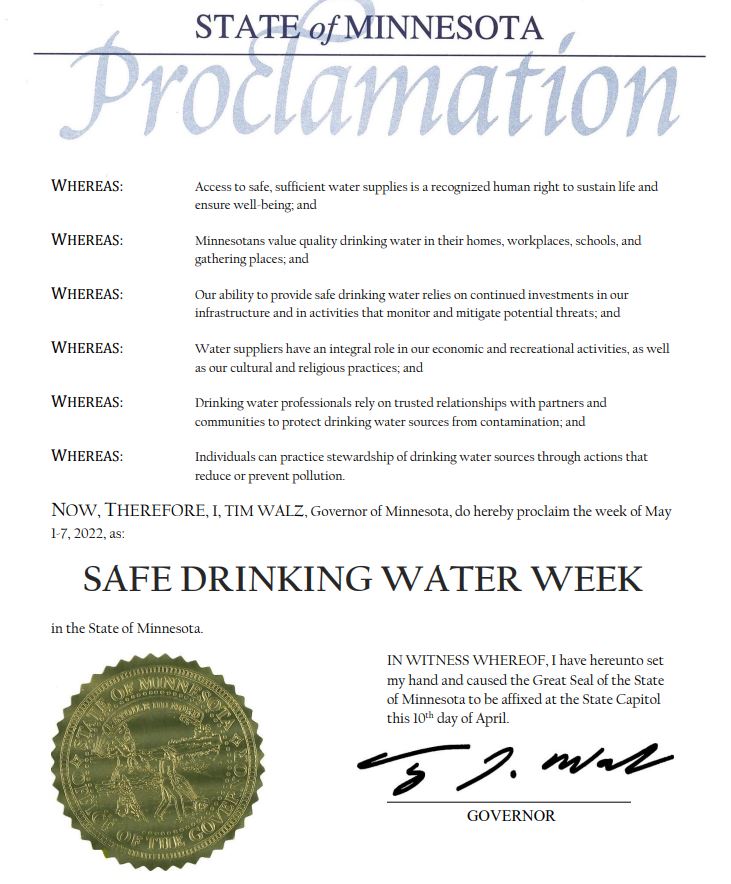Drinking Water Protection
- Drinking Water Protection Home
- About Us
- A-Z Index of Contaminants in Water
- Community Public Water Supply
- Drinking Water Grants and Loans
- Drinking Water Institute
- Drinking Water in Schools and Child Cares
- Drinking Water Revolving Fund
- Laws and Rules
- Noncommunity Public Water Supply
- Source Water Protection
- Water Operator and Certification Training
- Drinking Water Protection Contacts
Related Topics
- Annual Reports
- Drinking Water Risk Communication Toolkit
- Drinking Water Protection External Resources
- Fact Sheets
- Forms
- Invisible Heroes Videos: Minnesota's Drinking Water Providers
- Noncom Notes Newsletter
- Sample Collection Procedures (videos, pictures, written instructions)
- Waterline Newsletter
Related Sites
- 10 States Standards
- Clean Water Fund
- Health Risk Assessment – Guidance Values and Standards for Water
- Minnesota Well Index
- Water and Health
- Wells and Borings
Environmental Health Division
Waterline: Summer 2022

Editor:
Stew Thornley
Subscribe to The Waterline newsletter. An e-mail notice is sent out each quarter when a new edition is posted to the web site.
On this page:
- Bemidji Building to Meet the Future
- MDH Issues Drinking Water Annual Report Covering 2021
- Coming and Going: Hunter Blommel Joins MDH; Lih-in Rezania Leaves after Nearly Three Decades
- WUTT's Rolling Along
- Bemidji Builds Treatment Plant to Remove PFAS
- Water Operator Schools Back and Going Strong
- MRWA Apprenticeship Program
- Did You Know?
- Words to Live By
- Reminder to All Water Operators
- Calendar
Bemidji Building to Meet the Future

The city of Paul Bunyan, a commercial and recreational gateway in northern Minnesota, has responded to per- and polyfluoroalkyl substances (PFAS) with a new water treatment facility that is a win-win in removing PFAS while also enhancing the aesthetic qualities of the water. See below for the full story.
Go to top
MDH Issues Drinking Water Annual Report Covering 2021
Governor Tim Walz declared May 1-7, 2022 Safe Drinking Water Week in Minnesota. In conjunction with this, MDH released its Drinking Water Annual Report, which includes monitoring results from 2021.
The Minnesota Department of Health (MDH) issued its annual report on the state of drinking water in Minnesota on May 2. The report, first issued in 1995, covers monitoring results from 2021.
One of the highlights is that out of more than 6,600 public water systems in the state, no system exceeded a maximum contaminant level for pesticides and industrial contaminants. Even at trace amounts, only .23 percent of the 32,523 separate tests for these contaminants indicated a detection.
More than 98% of the population served by community water systems have drinking water meeting all federally established health-based standards.
A Strategic Initiatives section of the report highlights issues such as PFAS, health equity, and the revised Lead and Copper Rule along with updates on lead service line replacements.
Go to top
Coming and Going: Hunter Blommer Joins MDH; Lih-in Rezania Leaves after Nearly Three Decades

Hunter Blommer (above and below) has joined the Minnesota Department of Health as a district engineer based out of St. Cloud. He will be covering the Central South District. Born and raised in St. Cloud, Hunter got his environmental engineering degree from St. Cloud State University. He spends most of his free time hanging out with family and friends, and he loves bowhunting, ice fishing, and patrolling the outfield for the St. Joseph Joes in the Sauk Valley-West League. Hunter has a cat, Frank.
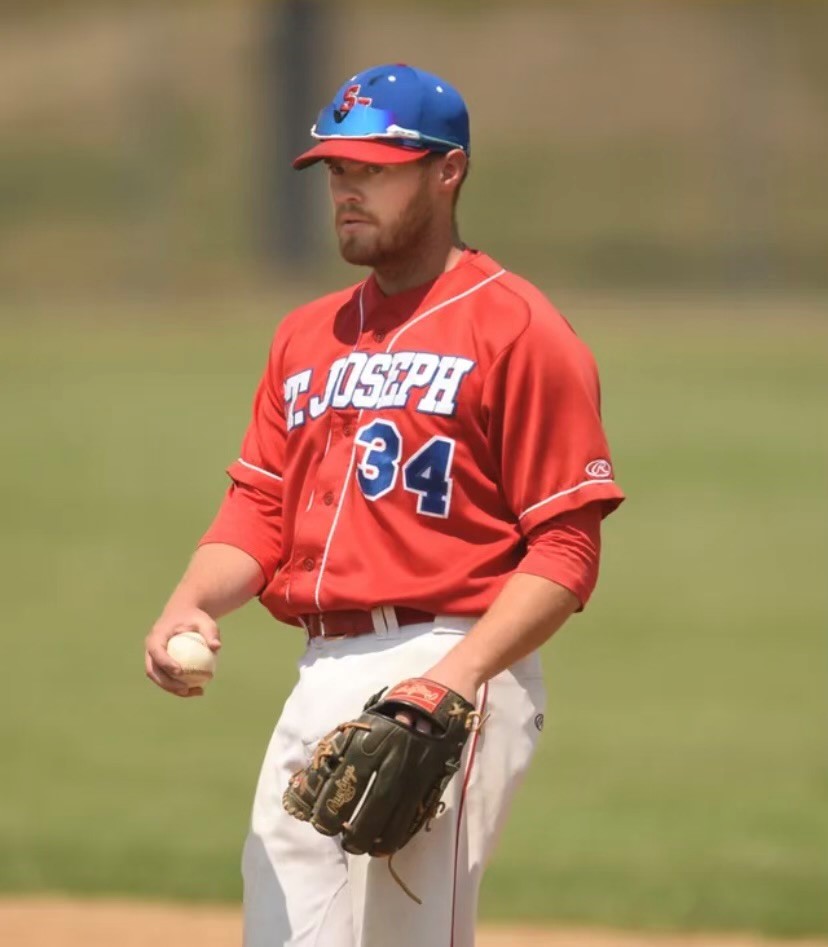
In her 29-1/2 year career at MDH, which ended April 5, Lih-in Rezania (below) was personally responsible for keeping more than two tons of lead out of public water systems in Minnesota. She joined the department in 1992, the same year that the Environmental Protection Agency’s Lead and Copper Rule began. She has worked with many systems since that time to optimize their corrosion control procedures. Keeping this much lead out of water and out of people’s bodies has made an immeasurable impact on public health in the state.
Lih-in got her bachelor’s degree in civil engineering in Taiwan and was offered a research position at the University of Texas, Arlington. However, she accepted a similar position from the University of North Dakota because she had never seen snow and wanted to experience winter. (Nothing says experiencing winter like living in Grand Forks.) A man named Shahin Rezania met her at the airport; three years later they were married.
Shahin retired after many years at Minneapolis Water Works a month after Lih-in’s retirement and they have moved to Sacramento County in California. They’ve kept their cabin on Jack the Horse Lake in Itasca County and plan to return in the summers to canoe, kayak, and swim with their daughter, Zay; son-in-law, Jake; and son, Zaul.
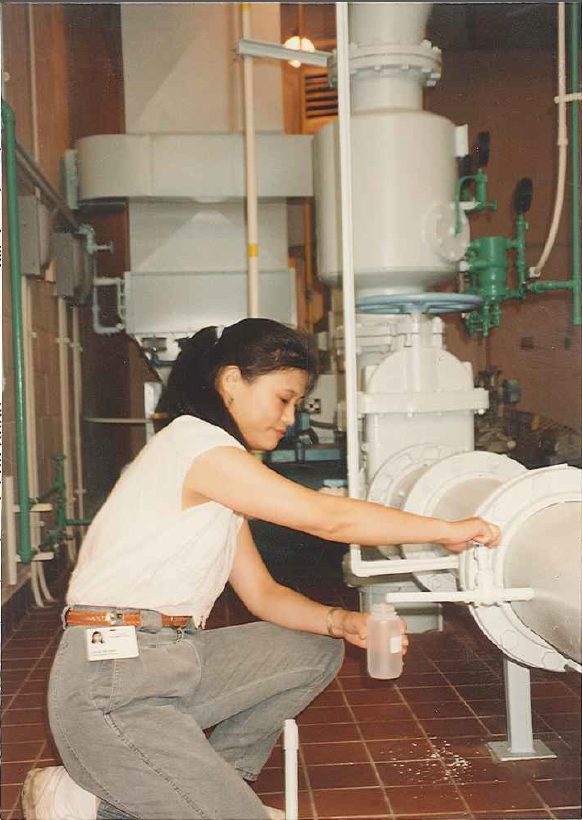
Go to top
WUTT's Rolling Along
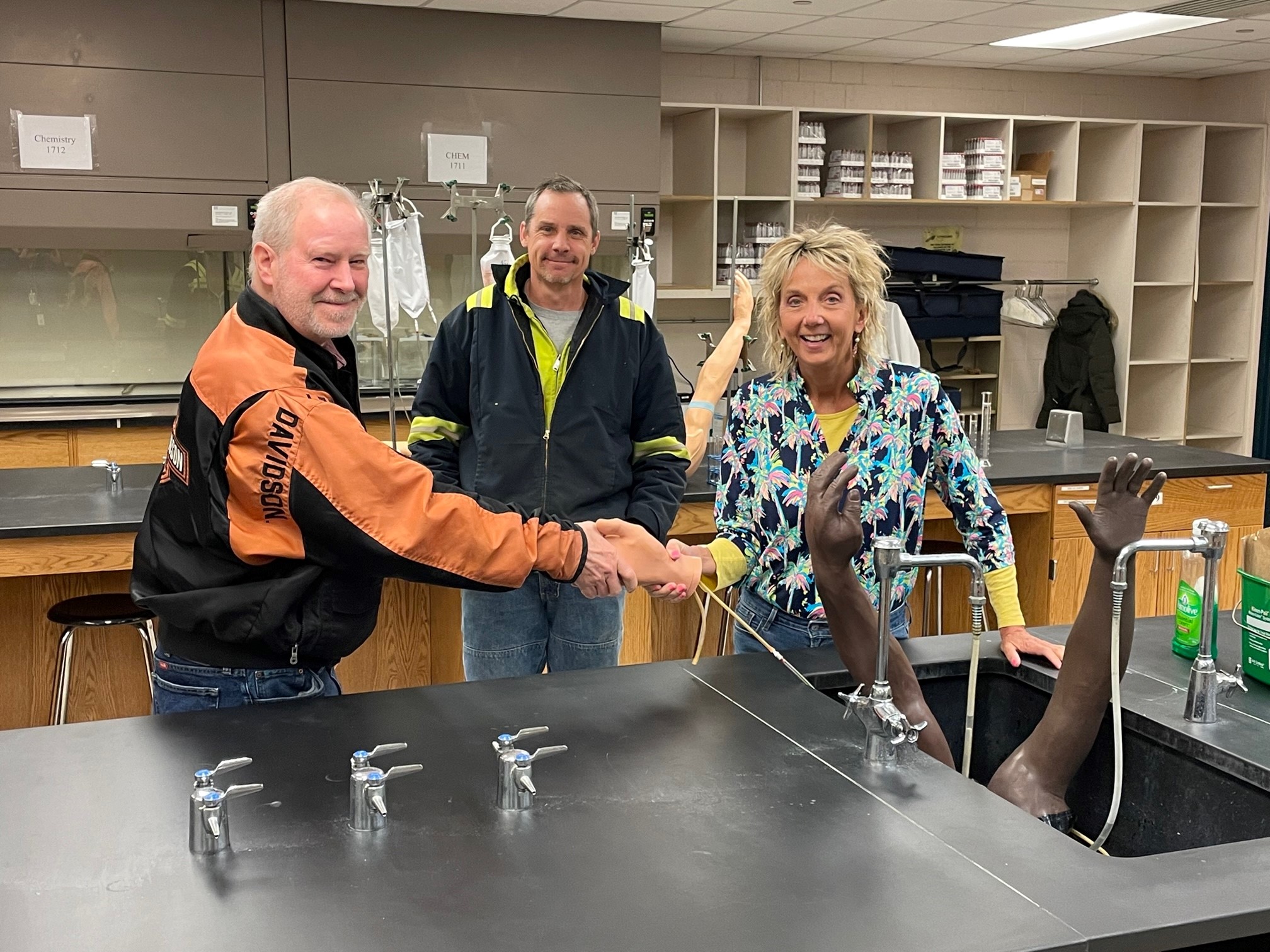
Recent retiree Paul Coone (left) and Carol Kaszynski (right) shake hands in front of Derek Goddard, the Golden Valley water distribution specialist. (The lab is used for a variety of activities—hence, the mannequin arms emerging from the sink.) Although retired from the city of Roseville after 40 years in the water profession, Paul will continue to be an instructor in the Water UtilityTreatment & Technology (WUTT) program at St. Paul College. Carol, the asset manager at Metro Transit for the Metropolitan Council, heads the WUTT advisory board, which welcomed Derek to its ranks. Below, SUSA met with the advisory board April 27 to learn more about the program and ways to recruit students.
More information: St. Paul College Workforce Training & Continuing Education: Water Utility Treatment & Technology
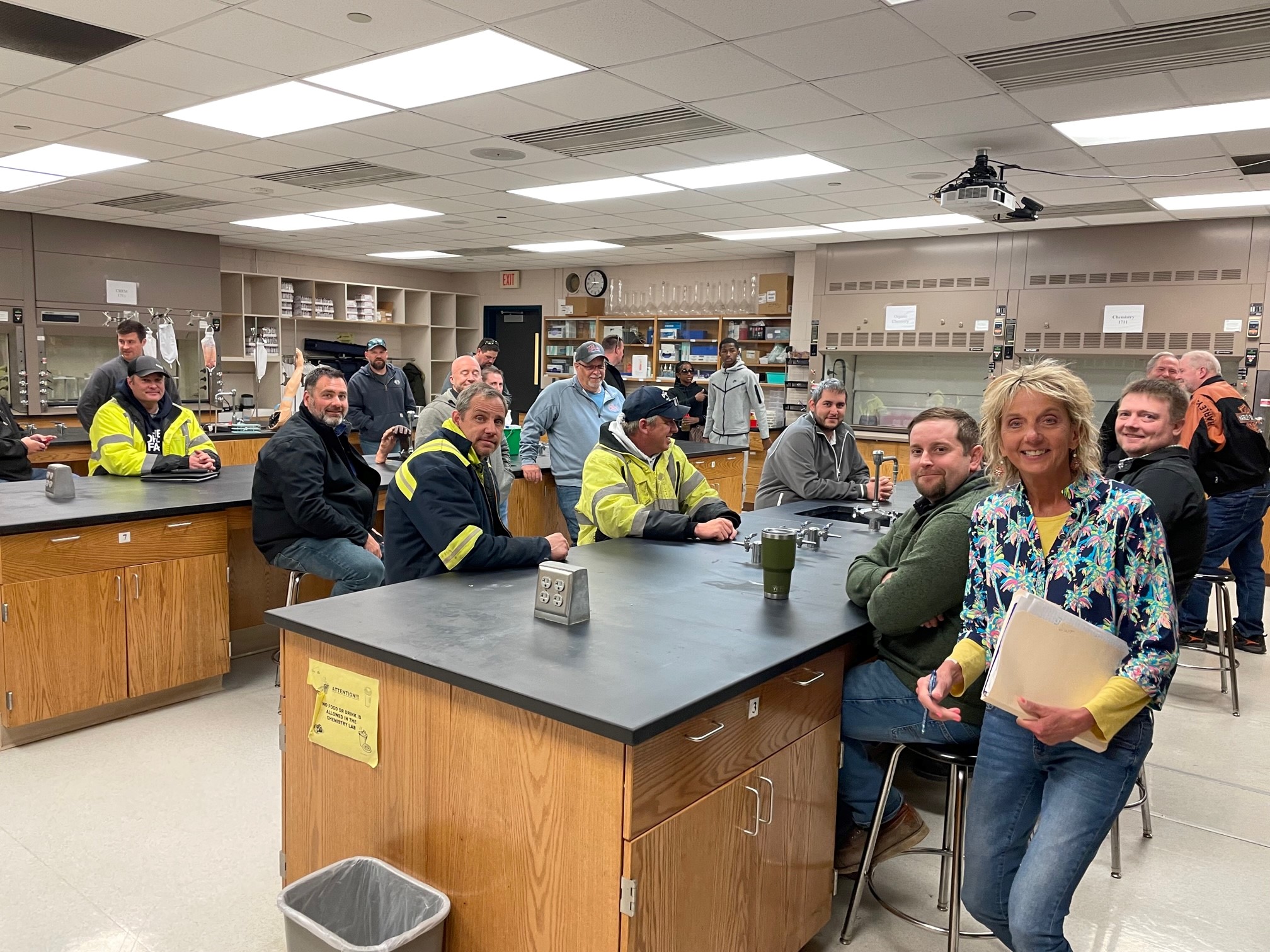
Go to top
Bemidji Builds Treatment Plant to Remove PFAS
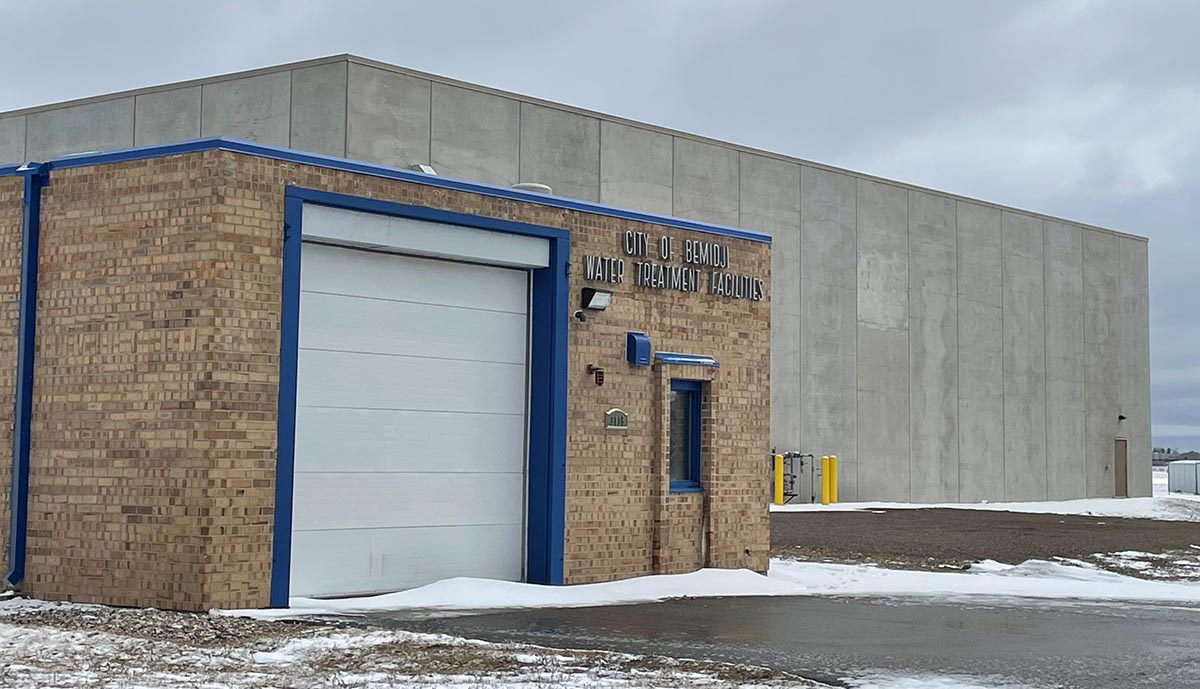
The old and new water treatment facilities in Bemidji. The one in the foreground will be demolished in the next phase of construction.
With more than 15,000 residents, Bemidji is the largest commercial center between Duluth and Grand Forks. While Lake Bemidji is the northernmost lake feeding the Mississippi River, Bemidji can boast of being “The First City on the Mississippi.”
Bemidji is known for the large and mythical, most notably with a statue of Paul Bunyan, but it has its share of real (albeit smaller) personalities. Born in Bemidji, Jane Russell moved to California and ended up with a star on the Hollywood Walk of Fame. Charles Scrutchin was a pioneering African American lawyer who came to Minnesota in 1898 and began practicing law in Bemidji. And the body of Lobo, a wolf who killed more than 100 deer a year before being captured, is stuffed and on display at Morrell’s Chippewa Trading Post in Bemidji.
A popular destination, Bemidji is accessible by highways, and it is also a regional hub for air travel. Its airport, in the northwest corner of the city, has been used as a training area for firefighters. As was the case at many sites around Minnesota, the airport executed required firefighting training using Class B firefighting foams, which are used for flammable liquid fires. Class B foams—also known as aqueous film-forming foam (AFFF)—contain per- and polyfluoroalkyl substances (PFAS), which for years were used in the manufacturing of a number of products, including nonstick cookware coatings and carpet and textile finishes.
In the early 2000s, PFAS began to be detected in soil and groundwater at sites that used AFFF for firefighting training. Concerns about impacts on drinking water became acute at training sites that were near wells. Along with the Minnesota Pollution Control Agency, the Minnesota Department of Health (MDH) began sampling water supply systems around the state at locations where AFFF was used for training.
The Bemidji water treatment facility is located on the edge of the airport property, and Bemidji’s five wells—ranging in depth from 150 to 180 feet—are on airport property. The city’s water treatment entailed sequestering iron and manganese at each well using polyphosphate and adding fluoride and chorine at the facility.
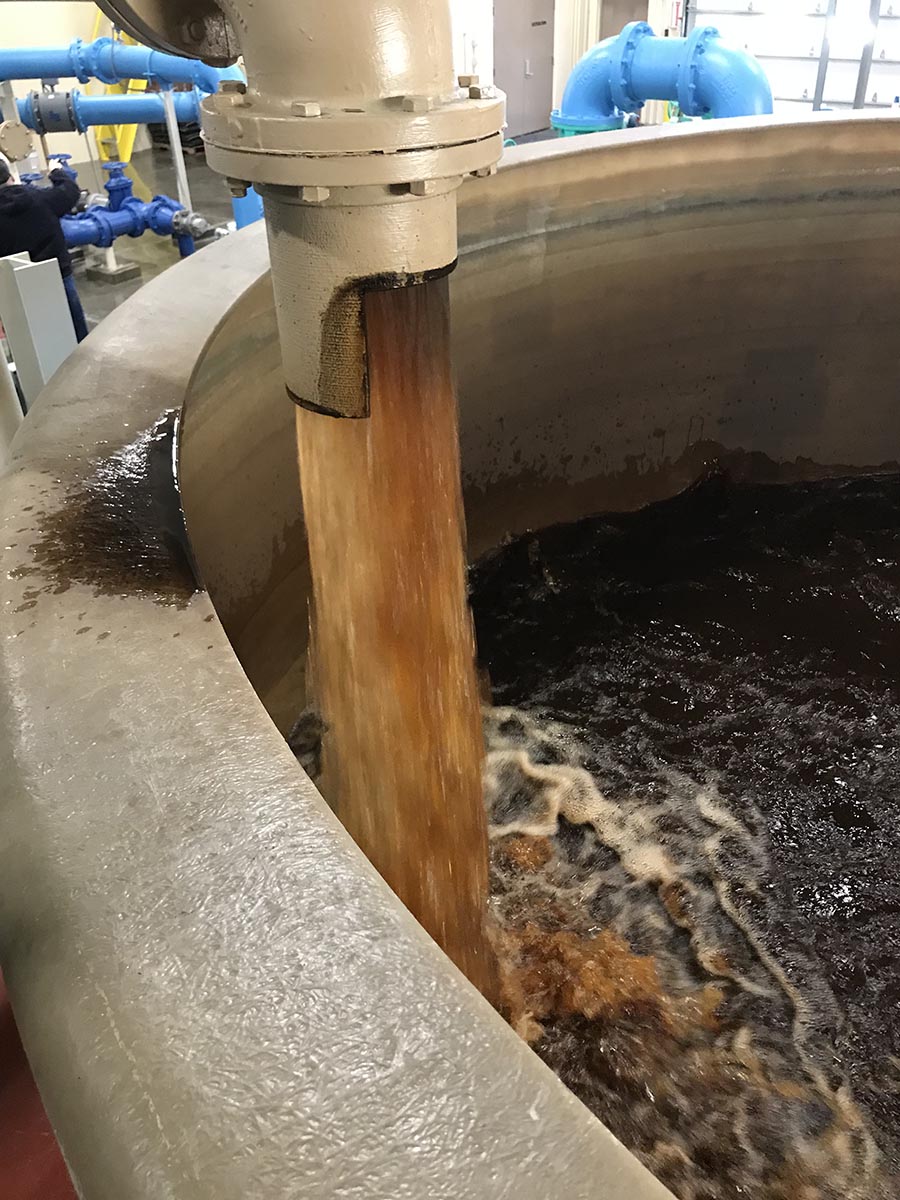
Backwashing at the Bemidji facility.
MDH district engineer Todd Johnson said they found no traces of PFAS in Bemidji’s water during sampling in 2009. However, low levels were detected in 2015 with sampling performed for the U. S. Environmental Protection Agency’s (EPA) third Unregulated Contaminant Monitoring Rule. The monitoring results were higher than most sites tested across the state, so MDH continued sampling on a quarterly basis. In 2017, MDH lowered its health-based guidance values (HBVs) for PFAS. “That’s when things started to pinch the cities,” said Johnson.
When the guidance values were updated in 2017, the PFAS levels in two of the wells exceeded them; MDH issued a health advisory for those wells and eventually for all of the wells. Bemidji responded by hiring Barr Engineering Company of Minneapolis to identify immediate and long-term actions to maintain compliance and provide safe drinking water.
Taking Action
Two of Bemidji’s wells had higher levels of PFAS than the others. The city was able to supply water below the MDH guidance levels by primarily using the wells with the lowest PFAS concentrations. Groundwater modeling was performed to predict how quickly the water quality would change with the modified pumping schedule.
Barr and the city also explored three sites for a new wellfield, locations that would be close to the existing facility but far enough away to be out of the PFAS contamination plume. MDH engineer Eric Weller said a test well at the north end of the airport, upgradient of the plume, had issues with heavy metals. “The new well would have drawn in undesirables,” said Todd Anderson, the water plant superintendent.
Although it came up short on finding a suitable alternate water supply, the city wasn’t fazed. Concurrent with looking at a new wellfield, Bemidji pilot tested treatment technologies to remove PFAS from its existing wells.
Treatment Options
Barr and the city studied granular activated carbon (GAC) and two different single-pass ion exchange resins. Barr facilitated a GAC accelerated column test, a common method for assessing breakthrough curves and identifying which PFAS compounds would show up in the effluent first as the carbon was exhausted. In addition, an on-site pilot test for ion exchange treatment was operated by city staff.
Based on results and costs of the different treatment technologies, Bemidji selected GAC as the long-term option. The versatility of GAC in dealing with PFAS and other contaminants of emerging concern, ones that may require treatment in the future, was one of the factors in the decision.
During the accelerated column and pilot testing, Johnson noted that iron and manganese fouled the treatment media. Pretreatment was needed, and, as a result, iron and manganese treatment (five vessels filled with anthracite and greensand) was added to the final design. “It killed two birds with one stone,” said Johnson, as the pretreatment has improved the overall aesthetic quality of the water while keeping iron and manganese from fouling the GAC media. The GAC vessels consist of three lead/lag treatment trains for a total of six filters.
Because iron and manganese are removed at the plant, polyphosphate is no longer needed at the wells; however, because of additional pressure created by the new treatment systems, the city has upgraded the pumps at two wells with plans to upgrade the other three in a future phase.
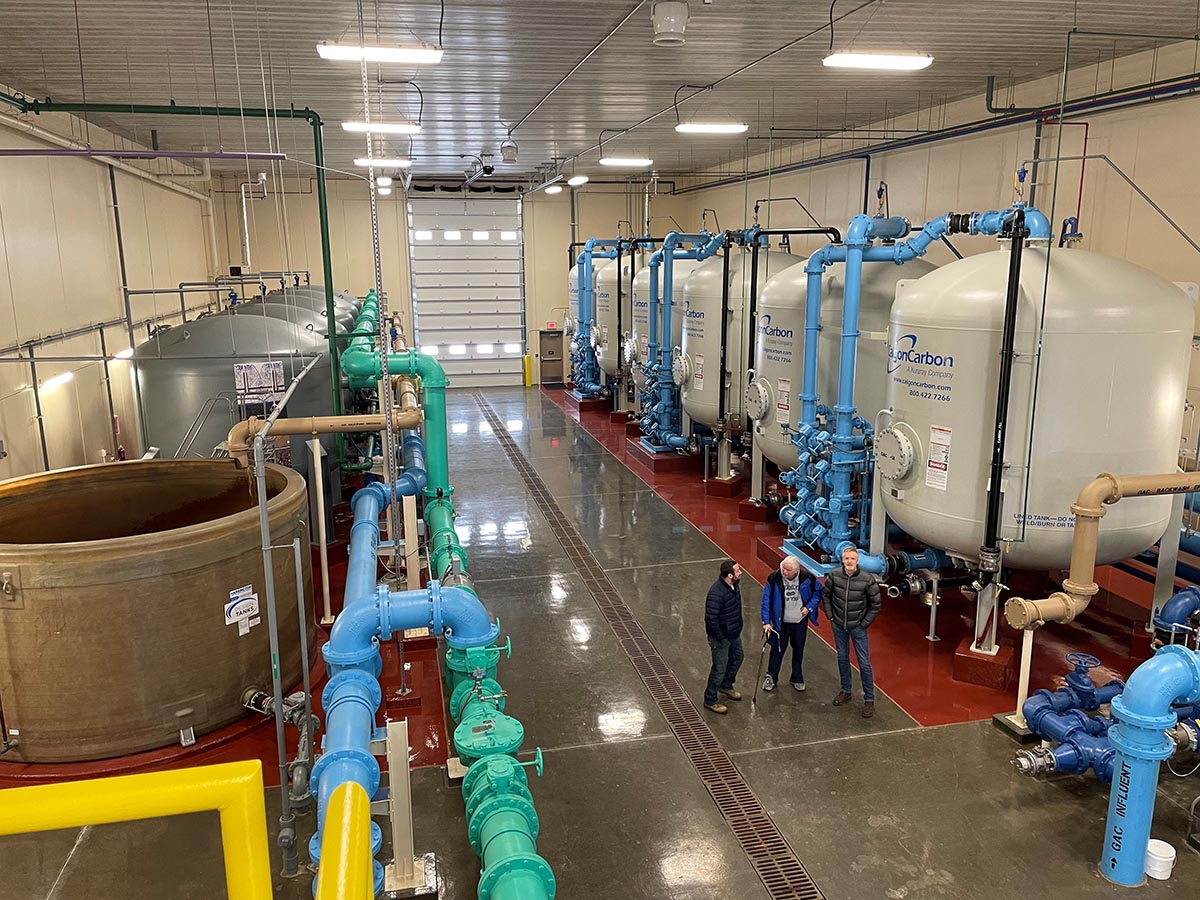
The greensand filters for iron and manganese treatment are on the left, the granular activated carbon filters for removal of PFAS on the right.
Plant Options
Because of the need to implement treatment as soon as possible, the city considered having temporary treatment for PFAS removal before constructing a full-scale plant. “First we looked at a tent and then a shed as a way to temporarily house the treatment equipment,” said Anderson. However, Barr found that a permanent plant, constructed with pre-cast concrete panels, could be built while still meeting the city’s timeline.
Craig Gray, Bemidji’s public works director and city engineer, said, “By the time we ran all the numbers, we decided we would have wasted money,” referring to using a temporary plant. By building a permanent plant, “None of this will be wasted money.”
Because of the time crunch for getting moving, Bemidji issued four separate bid packages. The first three were for the procurement of concrete panels and the treatment equipment systems. The fourth was for the general contractor, Rice Lake Construction of Deerwood, Minnesota, which then incorporated the first three bid packages into their scope. Normally bid as one package, the construction was accelerated with this method, and the (Phase I) plant began continuous operations in March 2021, only 14 months after the start of design.
“It went really well,” Johnson said. “There were no coordination issues.”
The city covered the $7.5 million cost for design and construction through the sale of utility bonds and a rate increase of seven percent.
What’s Next?
Bemidji isn’t done. The city knew that the new Phase I plant was only the first of multiple phases. The plant was designed with knockout panels at the east end that could be removed for future expansion.
The Phase I plant capacity is 1,500 to 1,800 gallons per minute (gpm). Gray said their summer peak is 2,100 gallons per minute, which they can meet with the 1.75 million gallons of storage in three towers. Phase II will add four greensand filters and two trains of GAC vessels, bringing the capacity to 2,500 gpm.
Construction for the expansion will begin in the summer of 2022 and includes a new structure for chemicals, offices, and a garage. When this work is completed, the existing plant, which now has the chemical feed equipment, will be demolished.
Phase II is being covered with $10.2 million the city is receiving from a state bonding bill passed in 2020. Bemidji has a two-year construction time frame, from June 2022 to June 2024, to account for potential supply issues with concrete panels and treatment equipment.
In addition to the bonding bill, the city received $12 million from a settlement with the 3M Corporation, which manufactured the PFAS contaminants. This money will be used for maintenance and operation for the next 50 years. Gray anticipates replacing the GAC every two to three years, a tab that, with disposal of the used carbon, will cost about $200,000 each time.
The new plant is removing PFAS from the water supply as well as keeping the plume from migrating to private wells to the east. In addition to the MDH guidance values that have been established and revised, the EPA is expected to set maximum contaminant levels for perfluorooctane sulfonic acid (PFOS) and perfluorooctanoic acid (PFOA), two specific PFAS substances.
“As we got going,” said Anderson, “we didn’t know if we were looking at a five-year, 50-year, or 400-year problem.” With its new plant, Anderson and the others are confident that the city will be able to successfully navigate future treatment needs.
“This will take care of us for a long time,” said Gray, who also credited Weller and Johnson, the MDH engineers in Bemidji, for their contributions. “The local MDH office helped us big time.”
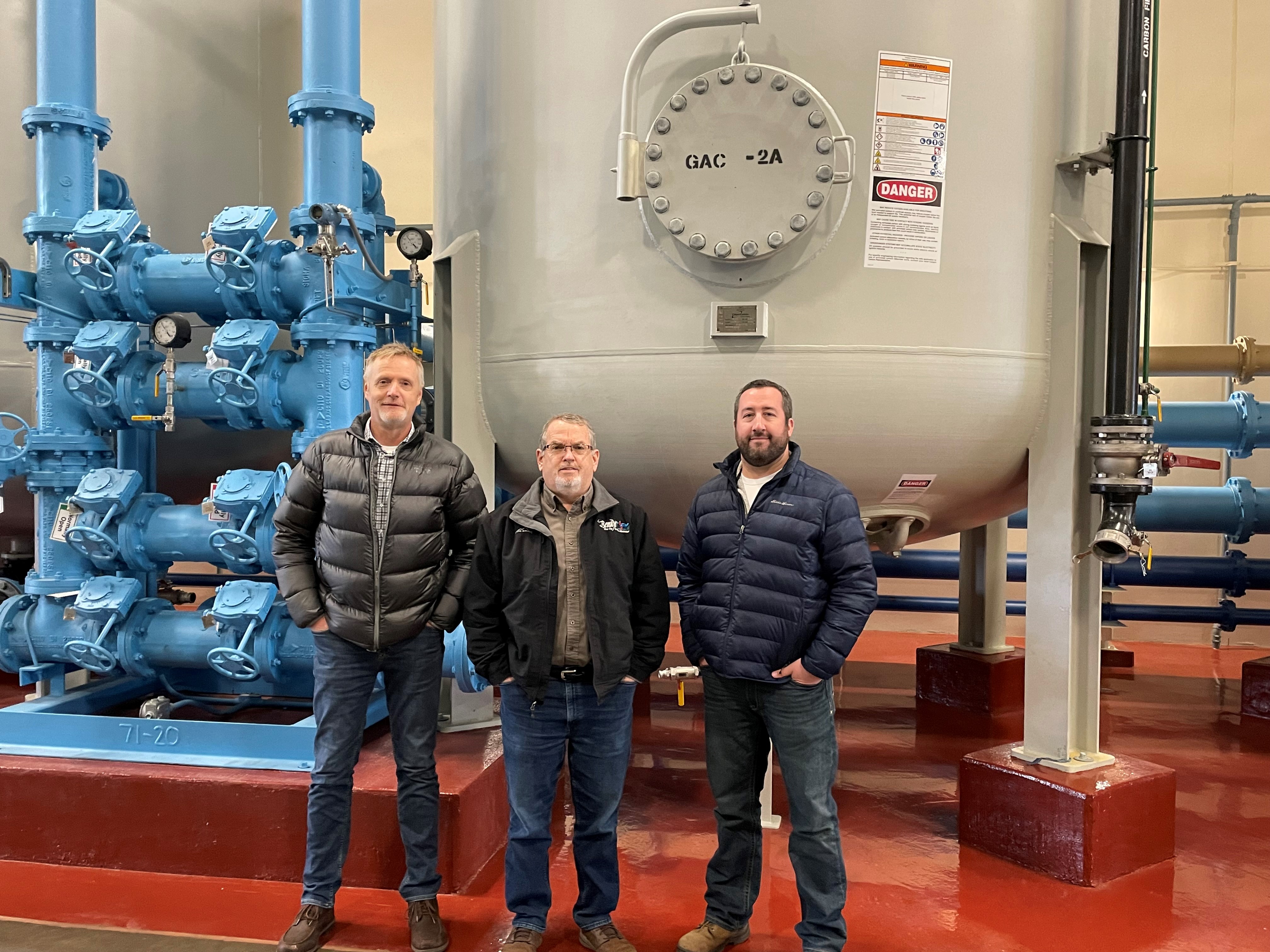
Todd Johnson, Craig Gray, and Eric Weller in front of one of the GAC filters.
Go to top
Water Operator Schools Back and Going Strong
After two years of water operator schools being canceled or held on-line, they are back in all districts in 2022.
The Southeast District held a three-day school in Rochester in March and will have a one-day school October 14 at Cabela’s in Owatonna..
The Southwest District held a one-day school in Redwood Falls in April and plans another for August 24 in Marshall.
The Central District has its one-day school at St. John’s University in Collegeville set for Wednesday, October 19.
The Northwest District opened up with an in-person school in Moorhead last October and has a three-day school planned for Detroit Lakes October18-20.
The Metro District, which held on-line schools in 2020 and 2021, was back in action in April, drawing more than 200 students along with more than 25 superintendents for a special session on its final day.
The Metro District plans to hold future schools in May in order to take advantage of potentially better weather and hold outdoor hands-on activities. The 2023 school will be at the Earle Brown Heritage Center in Brooklyn Center Tuesday, May 16 to Thursday, May 18. In the years beyond that, the district will look to have the school the first full week in May in conjunction with Safe Drinking Water Week in Minnesota.
Minnesota Water Operator Training Calendar
Go to top
MRWA Apprenticeship Program
Minnesota Rural Water Association (MRWA) has begun an apprenticeship program to help people entering the water and wastewater profession. In response to workforce challenges—with many operations specialists projected to retire in the next five years—the program has been designed to recruit, train, and retain employees.
The apprenticeship program involves incoming employees getting two years of hands-on training alongside an experienced operations specialist.
MRWA has more information for utilities and potential employees. Anyone interested in learning more may contact Joel Jasmer, 218-671-3475, joel.jasmer@mrwa.com.
Go to top
Did You Know?
The Barbie doll’s full name is Barbara Millicent Roberts, from Willows, Wisconsin.
The original name for the search engine Google was Backrub. It was renamed Google after the googol, which is the number one followed by 100 zeros.
Psycho was the first movie to show a toilet flushing.
It’s impossible to hum while holding your nose (just try it!).
There are over 200 dead bodies of climbers on Mt. Everest because it’s so difficult to bring them down.
Andrew Jackson had a pet parrot, which he taught to curse.
Go to top
Words to Live By
Life is not about how fast you run, or how high you climb, but how well you bounce.
Failure is cheap if we act on it, expensive if we don’t.
It isn’t what you know that counts; it’s what you can think of in time.
The best way to succeed in life is to act on the advice we give to others.
The person who starts by saying, “Maybe I’m wrong,” is often right.
One of the problems with committees is that members feel they have to take action, even if one is not needed, to justify their existence.
Do your worrying before you place your bet, not after the wheel starts turning.
Before you speak, make sure it’s an improvement on silence.
A successful person is the one who went ahead and did the thing the rest of us never quite got around to doing.
A truly great library contains something in it to offend everyone.
Dare to be different on the side of simplicity.
Go to top
Reminder to All Water Operators
When submitting water samples for analyses, remember to do the following:
- Take coliform samples on the distribution system, not at the wells or entry points.
- Write the Date Collected, Time Collected, and Collector’s Name on the lab form.
- Attach the label to each bottle (do not attach labels to the lab form).
- Include laboratory request forms with submitted samples.
- Do not use a rollerball or gel pen (the ink may run).
- Consult your monitoring plan(s) prior to collecting required compliance samples.
Notify your Minnesota Department of Health district engineer of any changes to your systems.
If you have questions, call the Minnesota Department of Health contact on the back of all sample instruction forms.
Go to top
Calendar
Operator training sponsored by the Minnesota Department of Health and the Minnesota AWWA will be held in several locations this spring.
Register for schools and pay on-line:
Go to top
